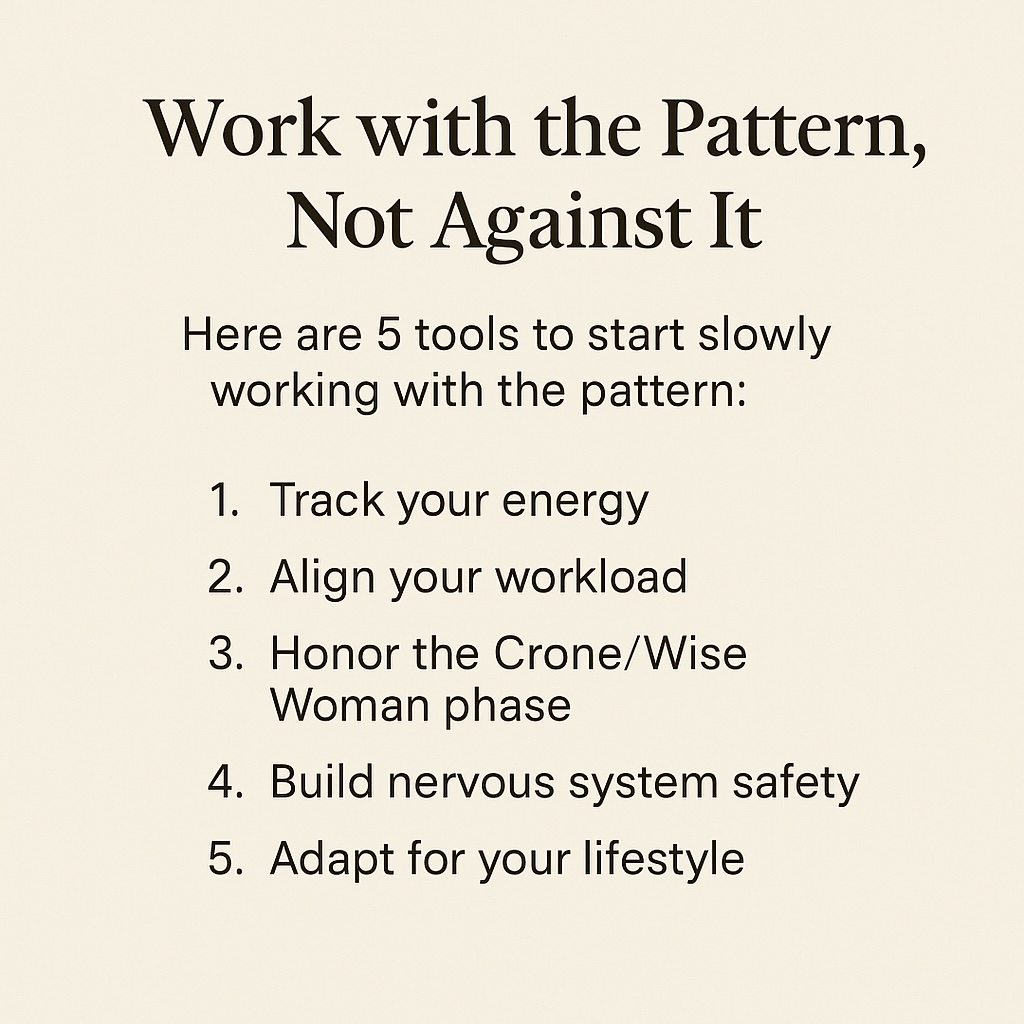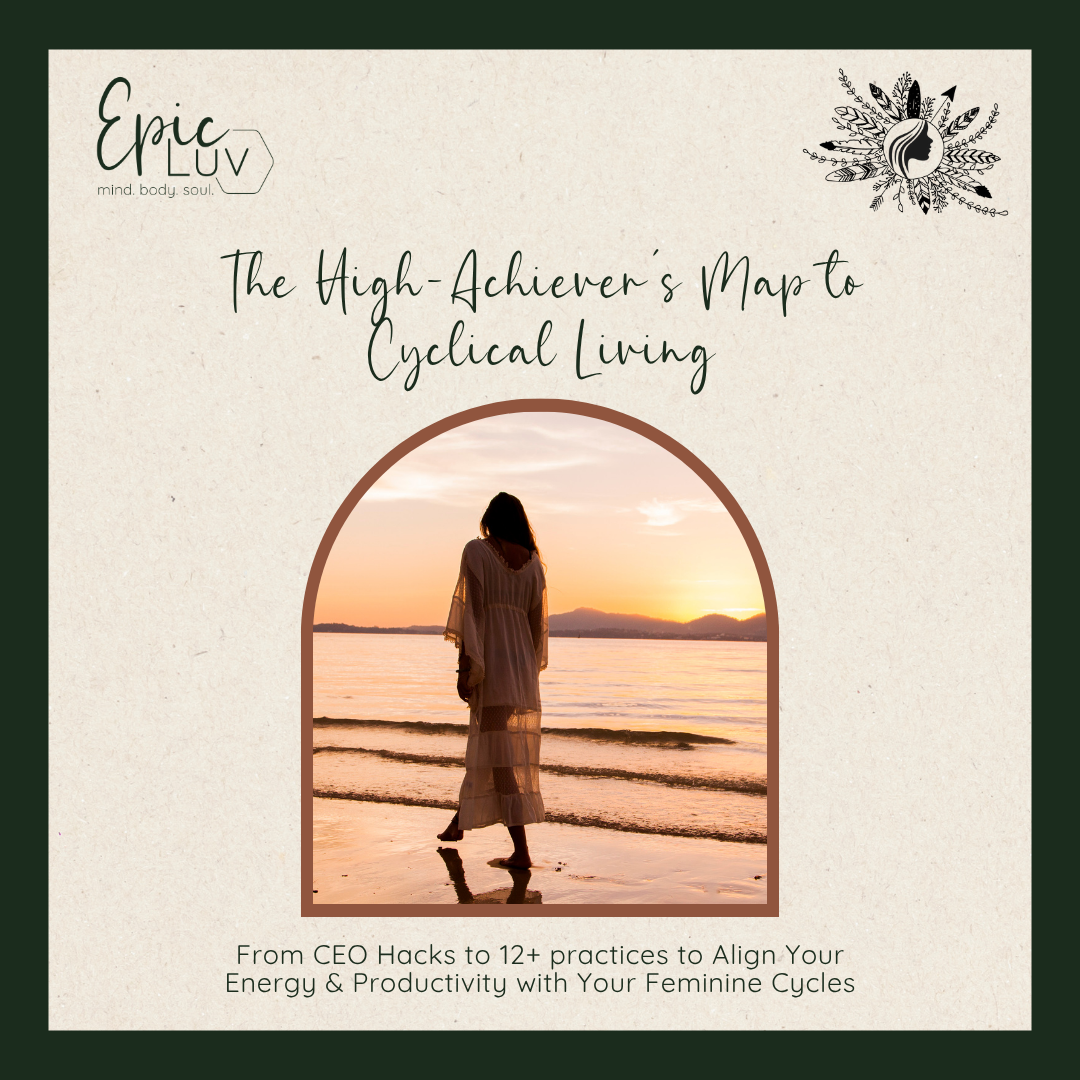The secret your body’s been trying to tell you all along
Some days you wake up ready to take on the world—clear, motivated, and unstoppable.
Other days, you can barely focus, everything feels harder, and you wonder what’s wrong with you.
Here’s the truth:
It’s not random.
It’s not “just stress.”
And it’s definitely not because you’re lazy or unmotivated.
There’s a biological pattern behind your energy highs and lows—one most women were never taught to notice, let alone work with.
The Problem: We’re Fighting Our Own Biology
Most women live as if their energy, focus, and productivity should be the same every day. That’s the standard we’ve been taught—and it’s a standard built for the male 24-hour hormonal cycle.
But your body isn’t on a 24-hour loop.
It moves through predictable highs and lows—whether monthly, seasonally, or in sync with the moon.
When you hit those lower-energy phases, your body is asking you to:
- Slow down
- Reflect
- Conserve energy
- Release what’s not working
Instead, most of us push harder—because we’ve been conditioned to see slowing down as weakness.
And when we try to slow down, our protector parts often step in to keep us in motion:
- The Achiever whispers, “You can rest when this is done.”
- The Perfectionist says, “If you stop now, it won’t be good enough.”
- The People-Pleaser worries, “What will they think if I say no?”
- The Inner Critic shames us with, “You’re being lazy.”
These parts were often built in childhood to keep us safe, loved, and accepted—but in adulthood, they can keep us locked in patterns of overdrive, even when our bodies are begging for rest.
📖 For more on how these protector parts form and how they impact your nervous system, read: The Invisible Cost of Always Being ‘On’.
Why There’s a Pattern

The rhythm you feel isn’t in your head—it’s in your hormones and your nervous system.
For menstruating women, hormonal changes over a 28-day cycle create natural peaks and valleys in energy, focus, and mood. Estrogen and testosterone tend to lift energy and confidence, while progesterone slows the body, preparing it for rest and renewal.
For women in perimenopause, shifting and inconsistent hormone levels can make the highs and lows feel less predictable—but the body is still cycling between phases of higher and lower capacity.
For women in menopause, while monthly hormonal cycles end, the body still responds to lunar phases, seasonal changes, and the stress-rest balance in your nervous system. You may feel more inward during new moons or seasonal transitions, and more outward during full moons or high-light seasons.
And underneath it all, your nervous system is tracking safety:
- When you have the resources, it allows you to expand.
- When you’re depleted, it calls you inward to recover.
This is why your “low” phases often happen in a predictable rhythm—it’s your biology and your body’s survival intelligence working together.
The Cost of Ignoring Your Low-Energy Phases
When you override your body’s natural need for recalibration, you’re not just tired—you’re creating long-term stress on your nervous system, hormones, and emotional well-being.
Here are 5 major costs of ignoring your body’s cues:
- Chronic Burnout – Your body adapts to constant overdrive by living on stress hormones, leaving you depleted and unable to recharge.
- Mood Instability – Irritability, anxiety, and overwhelm become the norm because your nervous system never gets a chance to reset.
- Brain Fog and Poor Focus – Without periods of rest, your brain’s clarity, problem-solving, and creativity suffer.
- Lower Immunity – Overriding rest phases suppresses immune function, making you more prone to illness.
- Loss of Self-Trust – When you constantly ignore your body’s signals, you lose touch with your own needs and intuition.
The Solution:
Work With the Pattern, Not Against It

Your energy highs and lows aren’t flaws—they’re instructions. When you understand and honor them, you move from fighting your body to working in partnership with it.
Here are 5 tools to start slowly working with—and shifting—your pattern:
1️⃣ Track Your Energy
Keep a simple daily log of your mood, focus, and physical energy. Patterns will emerge—whether they’re monthly, seasonal, or lunar.
2️⃣ Align Your Workload
Schedule high-output tasks during your “up” phases. Save lower-energy phases for reflection, admin work, or gentler tasks.
3️⃣ Honor the Wise Woman Phase
When you feel the pull inward, create space for stillness and release. Ask: What’s draining me? What’s ready to go?
4️⃣ Build Nervous System Safety
Practice breathwork, gentle movement, or body scans so your body knows slowing down is safe.
5️⃣ Adapt for Your Life Stage
Whether you’re menstruating, in perimenopause, or post-menopause, your energy pattern exists. It just might look different—and that’s okay.
Watch: Learning Your Energetic Mapping — The Crone/Wise Woman Phase
In this video, I share why the Crone/Wise Woman phase is essential:
She’s tired.
She needs rest.
She needs quiet.
She needs to feel and witness.
And she asks: “What do I need to let go of?”
When you honor this phase—monthly, seasonally, or with the moon—you stop hitting the same burnout wall and start using it as a powerful reset.
Why This Matters
When you work with your natural energy pattern instead of forcing yourself into constant output, you:
- Avoid recurring burnout
- Experience greater emotional stability
- Improve focus and creativity
- Strengthen your immunity
- Rebuild self-trust
Your Next Step

Free Resource: Your Feminine Rhythm is Not a Liability—It’s Your Superpower
There is a biology-backed, soul-aligned way to be successful without burning out.
The High Achiever’s Map helps you soften the hustle and reconnect to the wisdom within.
Upcoming Free Workshop

Living in Rhythm: How to Align Your Energy, Work, and Emotions With Your Inner Seasons
🗓 September 17th, 5:30 PM PT
💻 Live on Zoom
You’ll learn:
- Understanding Your Hormonal Shifts
- The Nervous System -Cycle Connection
- Aligning Life With Your Energy Seasons
- Breaking the Burnout Cycle
Final Thought
The life you want isn’t built in constant hustle—it’s built in rhythm.
Your highs and lows aren’t random—they’re a map.
Learn to read it, protect it, and live by it.




Her yazı özlü kılavuzlar bilgi açlığınızı doyuracak— kesinlikle okunmalı.